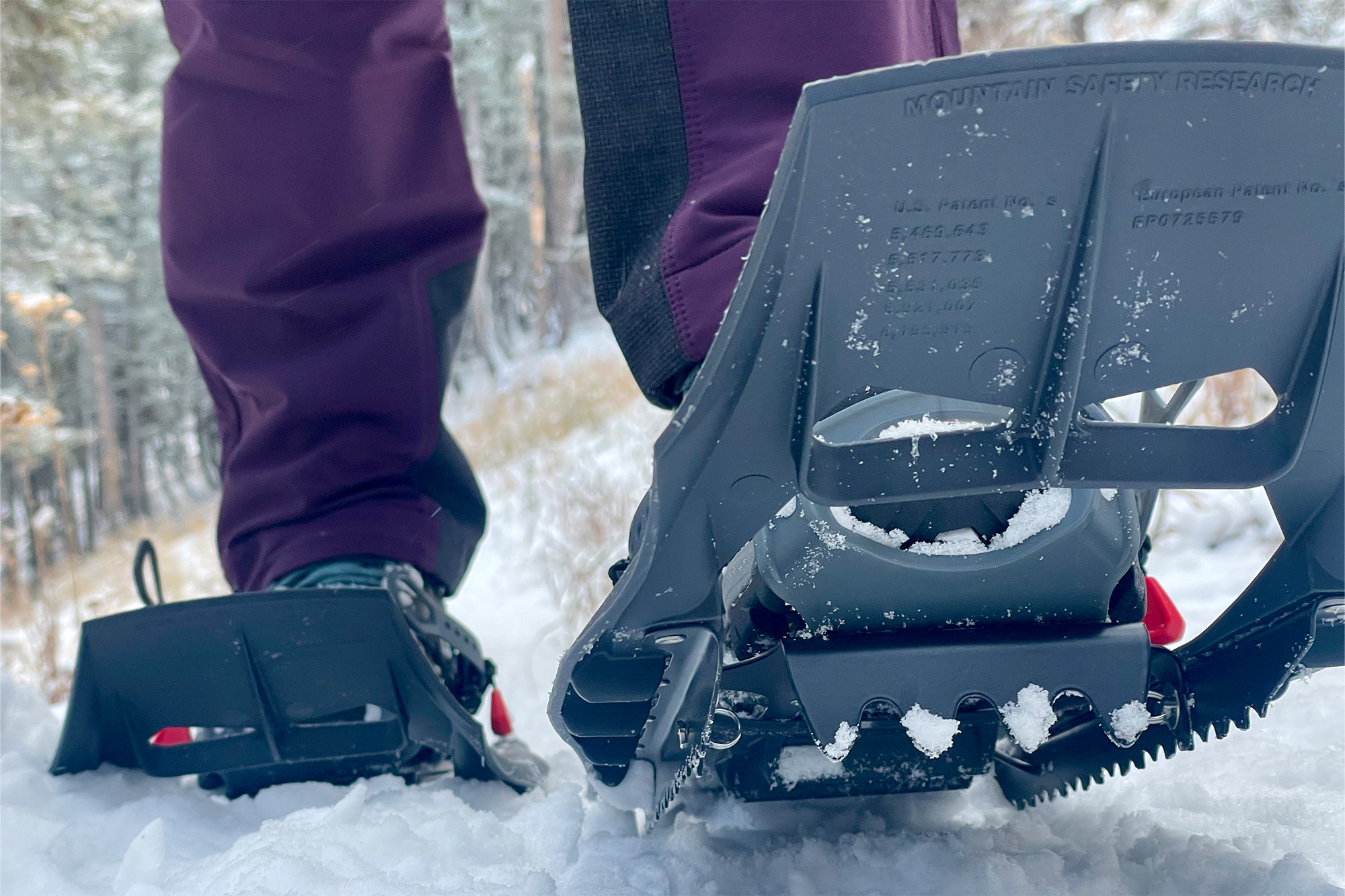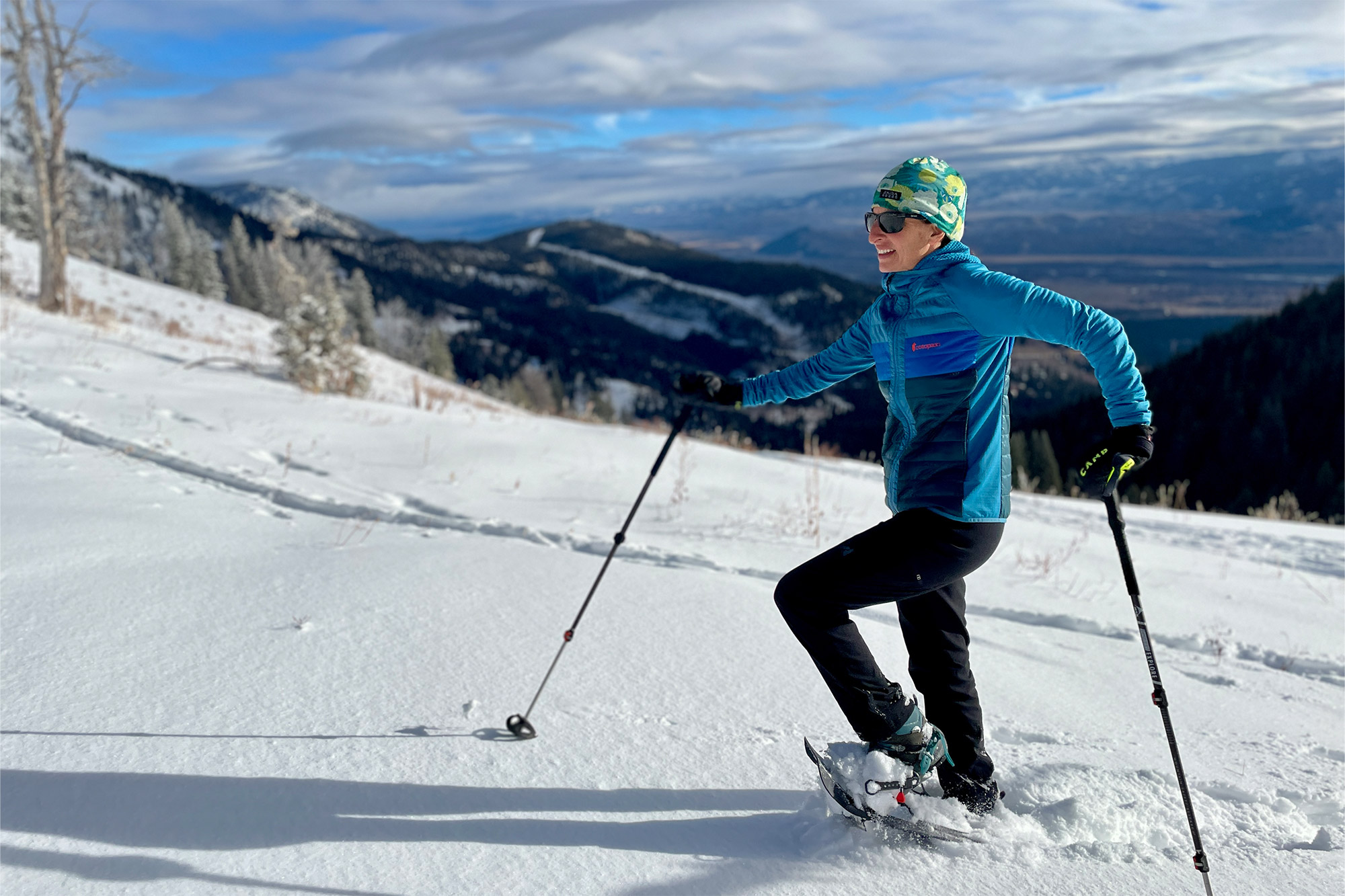It’s one of those bright winter mornings in Grand Teton National Park when the air feels crisp and the snow underfoot sparkles in the sunlight. The trail to Taggart Lake is covered with just a few fresh inches of snow, the kind that makes the world feel quiet and new.
A few friends have joined me for their first-ever snowshoe outing, and their mix of excitement and uncertainty reminds me how special these early experiences can be.
I hand each of them a pair of MSR Evo Trail ($170) snowshoes, a model I have stockpiled for mellow days like this. They’re durable, affordable, and incredibly easy to use, making them ideal for anyone stepping into the sport. Within minutes, everyone is strapped in and moving steadily along the trail.
Laughter replaces hesitation as they find their rhythm, the soft crunch of snow echoing through the trees. The Evo Trail has a way of taking the intimidation out of winter travel. It turns what could be a challenging day into something smooth, accessible, and genuinely fun.
In short: The MSR Evo Trail is the snowshoe I reach for when I just want to get outside without overthinking it. Made from a single piece of tough molded plastic, it’s nearly bombproof and simple enough for first-timers to figure out in minutes. The steel traction bars bite into packed snow and icy patches, while the flexible bindings stretch easily over almost any boot and stay comfortable even in the cold. It’s not meant for deep powder or steep alpine missions — but for rolling trails, frozen lakes, and everyday winter hikes, the Evo Trail delivers way more performance than its price suggests.
See how the MSR Evo Trail compares to others we’ve tested in our Buyer’s Guide to the Best Snowshoes.
-
Durable -
Solid traction -
Affordable -
Easy to use
-
Low max weight -
Not ideal in deep snow -
No heel riser
MSR Evo Trail Review
Flotation
The Evo Trail’s 22-inch deck offers just the right amount of flotation for packed or moderately covered trails. Its compact size keeps it maneuverable, which helps beginners find their stride without feeling awkward or wide-footed. On firmer snow, it maintains balance and support even with a small day pack.
For heavier users or deeper snow, MSR offers 6-inch modular tails ($55) that attach easily to extend the surface area and increase the maximum weight from 180 pounds to 250 pounds. Without tails, these snowshoes are best suited for shallower snow and groomed routes, where they feel stable, comfortable, and efficient.
Traction
Underfoot, the steel traction bars and crampons provide reliable bite on packed snow, icy stretches, and small hills. During a light climb and descent around the Tetons, I always felt secure, even on shaded slopes where the snow had firmed up overnight. The traction system offers enough control for rolling terrain without being overly aggressive.
While it cannot match the sheer grip of MSR’s technical Lightning Ascent model, the Evo Trail strikes an excellent balance between control and ease, keeping you sure-footed in the conditions most hikers will encounter.

Bindings
The Paraglide bindings are one of the Evo Trail’s most impressive upgrades. They are soft, flexible, and quick to adjust, stretching easily over a wide range of winter boots. The design eliminates pressure points, and toe stops guide your foot to the right position automatically. Even in freezing weather, the straps stay supple, and adjustments are simple to make with gloves on.
On a recent loop around Phelps Lake, my friends were able to get in and out of their snowshoes with no help after a quick demonstration. The system feels secure and intuitive, providing all-day comfort even on rolling, uneven terrain.

Stride Efficiency and Walkability
The Evo Trail feels natural from the very first step. Its shorter deck allows for a smooth, steady stride that feels closer to walking than trudging. Tail drag is minimal, and the narrow profile prevents that awkward, wide-legged waddle that can make snowshoeing exhausting.
On packed trails through the forest, I found myself moving comfortably and confidently, keeping pace with friends who had never worn snowshoes before. When we hit bare patches, these snowshoes were light and compact enough to strap easily to a pack. They are efficient, forgiving, and fun, which makes them a perfect fit for casual winter adventures.

Features
MSR’s UniBody molded deck has earned its reputation for toughness. It can handle rocks, roots, and repeat freeze-thaw cycles without cracking or bending. Integrated traction rails improve sidehill stability, and the overall design is simple and smart.
The Evo Trail accepts modular tails for extra flotation when you need it, but most hikers will find the standard deck more than capable for everyday use. The only minor drawback is that the hard plastic deck can be a little noisy on firm snow, interrupting the quiet rhythm of a winter hike.

Room for Improvement
The Evo Trail’s biggest limitation is its focus on mellow terrain. It lacks a heel riser, which would make long climbs more comfortable, and without the modular tails, flotation is limited in deeper snow. The plastic deck, while nearly indestructible, creates a slight clatter on icy trails.
None of these issues are dealbreakers for casual hikers, but they are worth noting for those planning to explore steeper or softer terrain conditions. If that sounds like you, the MSR Lightning Ascent might be a better choice. For everyone else, the Evo Trail delivers dependable performance that feels effortless and fun.

Who Is It For?
The MSR Evo Trail is for anyone who wants to enjoy winter without complication. It is ideal for first-time snowshoers, families, and friends heading out for casual hikes, as well as experienced adventurers who want a simple, no-fuss pair for everyday use.
They are compact, durable, and versatile enough to live in your car all season, ready for spontaneous snow days. Few snowshoes offer such an easygoing balance of reliability and fun for packed trails, frozen lakes, and rolling terrain.

Summary: MSR Evo Trail Snowshoes
All things considered, the MSR Evo Trail stands out as one of the most approachable, dependable snowshoes you can buy. It is lightweight, intuitive, and tough enough to handle years of winter adventures. While it lacks some of the features of more technical models, its durability, simplicity, and comfort make it an easy recommendation for anyone who wants to get outside and enjoy the snow without overthinking the gear.
Read the full article here





